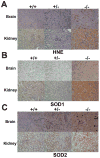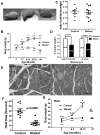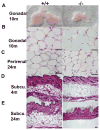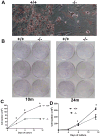Mitochondrial peptidase IMMP2L mutation causes early onset of age-associated disorders and impairs adult stem cell self-renewal
- PMID: 21332923
- PMCID: PMC3111879
- DOI: 10.1111/j.1474-9726.2011.00686.x
Mitochondrial peptidase IMMP2L mutation causes early onset of age-associated disorders and impairs adult stem cell self-renewal
Abstract
Mitochondrial reactive oxygen species (ROS) are proposed to play a central role in aging and age-associated disorders, although direct in vivo evidence is lacking. We recently generated a mouse mutant with mutated inner mitochondrial membrane peptidase 2-like (Immp2l) gene, which impairs the signal peptide sequence processing of mitochondrial proteins cytochrome c1 and glycerol phosphate dehydrogenase 2. The mitochondria from mutant mice generate elevated levels of superoxide ion and cause impaired fertility in both sexes. Here, we design experiments to examine the effects of excessive mitochondrial ROS generation on health span. We show that Immp2l mutation increases oxidative stress in multiple organs such as the brain and the kidney, although expression of superoxide dismutases in these tissues of the mutants is also increased. The mutants show multiple aging-associated phenotypes, including wasting, sarcopenia, loss of subcutaneous fat, kyphosis, and ataxia, with female mutants showing earlier onset and more severe age-associated disorders than male mutants. The loss of body weight and fat was unrelated to food intake. Adipose-derived stromal cells (ADSC) from mutant mice showed impaired proliferation capability, formed significantly less and smaller colonies in colony formation assays, although they retained adipogenic differentiation capability in vitro. This functional impairment was accompanied by increased levels of oxidative stress. Our data showed that mitochondrial ROS is the driving force of accelerated aging and suggested that ROS damage to adult stem cells could be one of the mechanisms for age-associated disorders.
© 2011 The Authors. Aging Cell © 2011 Blackwell Publishing Ltd/Anatomical Society of Great Britain and Ireland.
Figures





Similar articles
-
Examination of bioenergetic function in the inner mitochondrial membrane peptidase 2-like (Immp2l) mutant mice.Redox Biol. 2014;2:1008-15. doi: 10.1016/j.redox.2014.08.006. Epub 2014 Aug 28. Redox Biol. 2014. PMID: 25460737 Free PMC article.
-
The Immp2l mutation causes age-dependent degeneration of cerebellar granule neurons prevented by antioxidant treatment.Aging Cell. 2016 Feb;15(1):167-76. doi: 10.1111/acel.12426. Epub 2015 Nov 30. Aging Cell. 2016. PMID: 26616244 Free PMC article.
-
Oxidative stress is involved in age-dependent spermatogenic damage of Immp2l mutant mice.Free Radic Biol Med. 2012 Jun 1-15;52(11-12):2223-33. doi: 10.1016/j.freeradbiomed.2012.04.003. Epub 2012 Apr 19. Free Radic Biol Med. 2012. PMID: 22569411 Free PMC article.
-
Respiratory function decline and DNA mutation in mitochondria, oxidative stress and altered gene expression during aging.Chang Gung Med J. 2009 Mar-Apr;32(2):113-32. Chang Gung Med J. 2009. PMID: 19403001 Review.
-
Oxidative stress response elicited by mitochondrial dysfunction: implication in the pathophysiology of aging.Exp Biol Med (Maywood). 2013 May;238(5):450-60. doi: 10.1177/1535370213493069. Exp Biol Med (Maywood). 2013. PMID: 23856898 Review.
Cited by
-
Immp2l Enhances the Structure and Function of Mitochondrial Gpd2 Dehydrogenase.Int J Mol Sci. 2024 Jan 12;25(2):990. doi: 10.3390/ijms25020990. Int J Mol Sci. 2024. PMID: 38256063 Free PMC article.
-
Analysis of copy number variation in Alzheimer's disease: the NIALOAD/ NCRAD Family Study.Curr Alzheimer Res. 2012 Sep;9(7):801-14. doi: 10.2174/156720512802455331. Curr Alzheimer Res. 2012. PMID: 22486522 Free PMC article.
-
A mechanistic review of chinese medicine polyphenols on bone formation and resorption.Front Pharmacol. 2022 Oct 12;13:1017538. doi: 10.3389/fphar.2022.1017538. eCollection 2022. Front Pharmacol. 2022. PMID: 36313339 Free PMC article. Review.
-
An Endogenous Anti-aging Factor, Sonic Hedgehog, Suppresses Endometrial Stem Cell Aging through SERPINB2.Mol Ther. 2019 Jul 3;27(7):1286-1298. doi: 10.1016/j.ymthe.2019.04.019. Epub 2019 Apr 27. Mol Ther. 2019. PMID: 31080015 Free PMC article.
-
Generation of reactive oxygen species in adipose-derived stem cells: friend or foe?Expert Opin Ther Targets. 2011 Nov;15(11):1297-306. doi: 10.1517/14728222.2011.628315. Epub 2011 Oct 10. Expert Opin Ther Targets. 2011. PMID: 21981031 Free PMC article. Review.
References
-
- Behrens M, Michaelis G, Pratje E. Mitochondrial inner membrane protease 1 of Saccharomyces cerevisiae shows sequence similarity to the Escherichia coli leader peptidase. Mol Gen Genet. 1991;228:167–176. - PubMed
-
- Caplan AI. Adult mesenchymal stem cells for tissue engineering versus regenerative medicine. Journal of Cellular Physiology. 2007;213:341–347. - PubMed
-
- Chehab O, Ouertani M, Souiden Y, Chaieb K, Mahdouani K. Plasma antioxidants and human aging: a study on healthy elderly Tunisian population. Mol Biotechnol. 2008;40:27–37. - PubMed
MeSH terms
Substances
Grants and funding
LinkOut - more resources
Full Text Sources
Molecular Biology Databases

